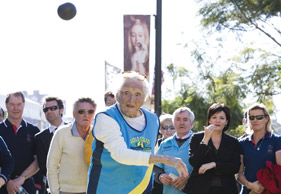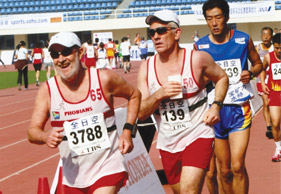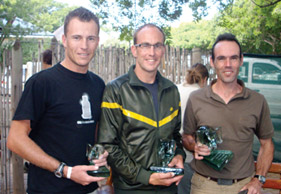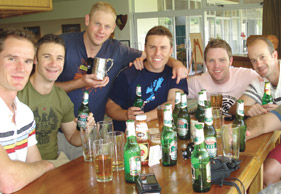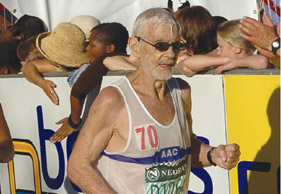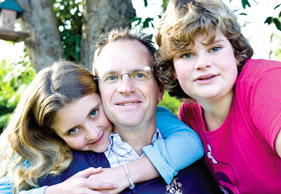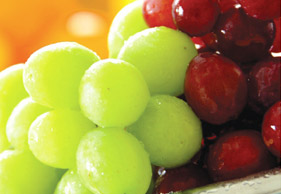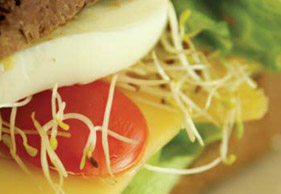He has become known as the desert runner, a man who has done nearly all of his running in the most dry, hot and windy places on Earth; over sand dunes, up mountains and on dangerous trails. Now he is ready to tackle the mother of all adventures – a 200km race through the Amazon Jungle, running amongst rodents the size of dogs and where leg guards are a necessity because of the huge snakes. And as the organisers of this race warn, the two most important things you should bring into the Jungle with you are your eyes. Modern Athlete spoke to Hout Bay runner, Ryan Sandes, about his upcoming race through the Amazon Jungle.
THE CHALLENGE OF A LIFETIME
Imagine running 200km through extreme terrain – sound tough enough? Now try doing it while keeping an eye out for snakes, over-sized rats and wild pigs. And if this is not enough, don’t think you are just going to run from point A to B. Swimming across creeks, negotiating rope crossings and making their way through mud, swamps and up hills all becomes part of a day’s run for competitors in the upcoming Jungle Marathon from 8 to 17 October. Not a race for the faint-hearted, especially when previous entrants say that if you run the Jungle Marathon once, you never return.
For Ryan Sandes, the Jungle Marathon is an ultimate challenge and in a couple of weeks he will be flying off to Brazil, mosquito net, hammock and all. After all, he knows how to look after himself in extreme races. He won the Gobi Desert Race in China and the Sahara Desert Race in Egypt, both 250km self-supported races over seven days and both part of the extreme Four Deserts Challenge.
Ryan, who has only been running for three years, stunned the sporting community last year when, as an unknown runner, he came from nowhere to win the Gobi and shortly afterwards the Sahara, making him not only the first South African to win these gruelling races, but also the first entrant ever to win each and every stage of both the Gobi and the Sahara. Time Magazine even named the Four Deserts Challenge as number two on its list of Top Ten Endurance Competitions in the world (the list includes such events as the Tour de France and the Dakar Rally).
27-year-old Ryan found out about the Jungle Marathon through fellow competitors. It is said to be one of the hardest marathons, not because of the distance, but rather because of the extreme conditions. Ryan has never been one to back off from extremes. “I like to try harder races than what I have done before. I try to push myself further. I have also never been to South America and to run there in such conditions will allow me to truly experience the environment. Hey, you only live once,” says Ryan, who has a BSc Degree in Construction Studies and an Honours Degree in Quantity Surveying from the University of Cape Town.
JUNGLE LIFE
The race, which will be held in Floresta Nacional do Tapaj?s, in Par?, Brazil, attracts competitors from all over the world. Entrants have the choice of two distances, 200km or 100km. The race is open to men and women, individuals and teams. There will be either four stages over four days (for 100km runners) or six stages over seven days (for 200km runners), varying in distance from approximately 16km to 87km. Each stage will have a maximum time for completion and any runner failing to arrive within the allocated stage time may be eliminated. The decision is taken by the race director and depends on the reasons for not finishing in time, the stage and the physical and psychological condition of the athlete.
The Jungle course is designed in a series of loops to minimize the spread of runners and facilitate emergency evacuations if required. Each stage is clearly marked with biodegradable tape. At each checkpoint, located every 5km to 10km, runners can replenish their water supply, rest and, if necessary, seek medical advice. Each checkpoint is also manned with military personnel, firemen to handle possible evacuations, a doctor or paramedic as well as two local guides from the particular area of the jungle to assist with the quickest route out of the jungle should someone be evacuated. The military firemen sweep each stage of the race one day in advance to double check for potential dangers. Although great navigational skills are not a prerequisite to compete in this race, common sense is. The route winds along pre-existing paths, on trails and tracks through primary jungle and around and through natural obstacles such as streams and rivers.
KISS YOUR COMFORTS GOODBYE
The Jungle is an unforgiving place where the weather can change from sizzling heat to pouring rain within minutes. Competitors have to carry all their own equipment and food and are only provided with water. “The humidity in the Jungle is about 97% and the temperatures range between 30?C and 40?C. You also have to be extremely careful of the terrain, as it is easy to hurt yourself by stepping into a hole covered by vegetation or leaves,” says Ryan.
On arrival in Santar?m, a city in the state of Par?, competitors are transferred by boat to the village of Alter do Ch?o. They then depart for an overnight trip on a boat to the Jungle base camp at Itapuama. “The journey on the boat is about eight hours and I hear it is quite crammed because everyone has to pitch their hammocks and sleep on the boat,” says Ryan.
TRAINING AND GEAR
The local jungle guides who help with trail preparation, as well as the military and fire service support teams, cover their arms, legs and heads when they are in the jungle because of the plants that can cut skin. If you don’t cover your skin, you are also more likely to get ticks as you cross swamps. But the scariest thought of all is that you have less protection against snake bites if there are no layers between the Jungle and your skin. Some even recommend snake guards that protect the legs from just below the knee to the top of the feet. Though snakes are not predators, they will attack when stepped on. “I decided against the snake guards. It looks too uncomfortable. I normally wear compression tights, but for this race I will wear full length tights to protect myself against scrapes and cuts,” says Ryan. He is also looking at ways to protect his feet from getting wet and while training, he deliberately runs through wet puddles to get his feet used to possible wetness.
Ryan’s backpack weighs about 9kg. Competitors need to be totally self-sufficient and take their own hammocks and some type of covering to keep warm at night when they sleep at campsites along the shores of the river. Like all other competitors, Ryan had to undergo a full medical examination as part of the entry process. He is planning to leave a week before the start of the race in order to acclimatise.
Ryan normally trains in a three to four week cycle, starting off with an easy week which builds up to a difficult week. His average weekly programme for big races includes:
| Monday: | Gym in the evening and sauna afterwards. |
| Tuesday: | Run for 15km to 25km including running in an environmental chamber at the Sports Science Institute of South Africa (one hour on the road and 40 to 60 minutes in the chamber). |
| Wednesday: | Run two to three hours on trails/mountains (with backpack). |
| Thursday: | Run for 15km to 25km including running in environmental chamber (one hour on road and 40 to 60 minutes in the chamber). |
| Friday: | Gym. |
| Saturday: | Three to nine hour run on trails/mountains (with backpack). |
| Sunday: | Three to five hour run on trails/mountains (with backpack) followed by gym and sauna. |
Ryan trains on trails around Hout Bay, Table Mountain, Cape Point and on the beach. He usually runs alone, but sometimes he has a buddy who joins him for two hours of his long run. “I get bored running on the road, but on trails it seems as if things get a lot clearer. Halfway through a six hour run, a lot of things clear up in my head. The only bad thing about running so much is that my social life has gone downhill!”
In the months leading up to the Jungle Marathon, Ryan has added a lot of gym work to his routine in order to strengthen his body. Training in the environmental chamber has also helped him. He runs on a treadmill in the chamber where one can control the heat and humidity. He sometimes pushes the heat up to 43?C and the humidity to 40%.
“I would love to win the Jungle Marathon. That’s the best case scenario, but I would be na?ve to think I can just go out there and win it on my first try. My goal is to try and finish it as quickly as possible, but anything can happen. You could be bitten by a snake and apparently there are giant rats and wild pigs to negotiate. If I see them, I will probably climb up a tree,” says Ryan, who admits he is terrified of snakes. He has woken up a few times in the last couple of weeks leading up to the race with nightmares about snakes. “I am nervous and scared in some ways, but also really excited about this race.”
KEEP GOING
After the Jungle Marathon, Ryan would like to complete the Four Deserts Challenge. He still has to do the Atacama Crossing in Chile and The Last Desert in Antarctica. His goal is to become the first person to win each of the 250km Four Desert Challenges. “And after that I would like to do some 100 miler races.” Ryan has found his passion in extreme races. “I really enjoy it, both the physical and mental side. You have to be strong mentally. It is a question of mind over matter. When I go through a bad patch, I always try and tell myself I am achieving a lot just by being there. I also try to break the race into segments.” It doesn’t seem as if Ryan has a lot of bad patches. He recently won the Hansa Hout Bay Trail Challenge in July in a record time of 4:17.
Ryan is one of several celebrities taking up a celebrity challenge in 2010. This challenge is part of Comrades 2010 and will see celebrities like Ryan, Ferdinand Rabie (Big Brother SA) and Garth Wright (former Springbok scrumhalf`) competing against each other.
Not bad for a man who entered his first marathon by chance in 2006. He has always been active, but never ran until his last year at varsity. He entered the Knysna Forest Marathon with friends; and only because entries for the half marathon were full. Ryan landed up finishing the marathon in 3:17 and shortly afterwards discovered his passion for trail running. “The feeling of competition and achieving goals got me hooked and I wanted to do more races.” He eventually came across the Four Deserts Challenge while surfing the internet. For Ryan, it was not only the perfect way of living his newfound passion, but also a good way of seeing the world. And he has been doing so ever since. As he says, “Live every day as if it is your last. Make the most of it and remember, what you put in is what you get out.”
CHECKLIST OF THINGS TO TAKE WITH YOU TO THE JUNGLE
- Mosquito net
- Rainfly sheet
- Food supplies to last for four to seven days of racing
- Insect repellent
- Compass
- Knife
- Compulsory medical kit
- Torch and spare batteries
- Waterproof matches or lighter
- Emergency whistle
- Water purifying tablets
STAGES OF THE JUNGLE MARATHON
The stage distances are approximately as follows, but are subject to change
- Stage 1: Departs 07:00 -16.3km – cut-off 17:30
- Stage 2: Departs 06:00 – 24.5km – cut-off 17:30
- Stage 3: Departs 06:00 – 31.1km – cut-off 17:30
- Stage 4: Departs 07:30 – 18.4km – cut-off 17:30 (End of 100km race)
- Stage 5: Departs 05:30 – 87km (This is a non-stop overnight stage) – cut off at 19:00 on second day of stage
- Stage 6: Departs 08:00 – 24.8km – cut-off 17:00 (End of 200km race)
ADVICE FROM ORGANISERS TO COMPETITORS IN THE JUNGLE MARATHON

